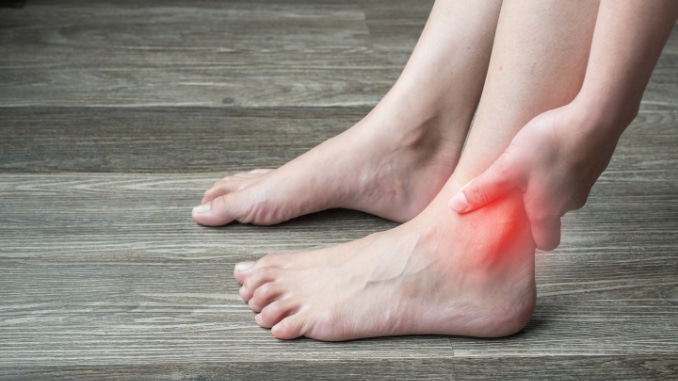Ankles are the foundation most of us often overlook when caring for our health. Although our ankles, composed of 26 bones, 33 joints, and an intricate network of tendons and ligaments, are complex structures, they are often neglected in our pursuit of overall well-being. Amid the busy pace of our everyday routines, we often overlook the quiet contributors that bear the impact of each stride—the unsung heroes, our ankles.
The Impact of Weak Ankles on Daily Life
The impact of weak ankles on daily life [1] is profound, influencing various aspects of mobility, stability, and overall well-being. Individuals with weak ankles often face challenges in routine activities such as walking, standing, and climbing stairs. The compromised stability can lead to an increased risk of slips and falls, and prolonged instability and not keeping the ankles straight might result in foot deformities.
Day-to-day tasks such as carrying groceries or navigating uneven surfaces become harder due to balance issues caused by ankle issues, potentially limiting one’s ability to engage fully in daily life. Weak ankles may contribute to a heightened awareness of the ground beneath, causing individuals to tread cautiously to avoid potential injuries.
Furthermore, the discomfort and instability associated with weak ankles can impact various activities. Addressing the impact of weak ankles with nonsurgical treatment involves physical interventions and targeted exercises; even something as simple as standing calf raises or tendon stretches can also help.
Anatomy of Weak Ankles
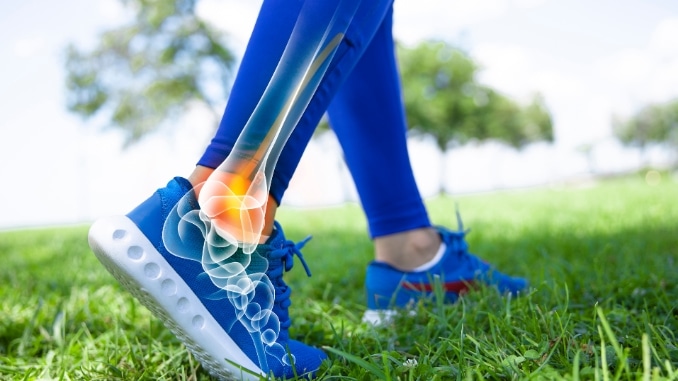
The term “weak ankles” typically refers to a condition in which the structures supporting and stabilizing the ankle joint are compromised[2], leading to a decreased ability to withstand stress and maintain stability. The anatomy of chronic ankle instability involves a complex interplay of bones, ligaments, tendons, and muscles.
Here’s a breakdown of the key anatomical components and how they may contribute to ankle weakness.
1. Bones
The ankle joint primarily consists of three bones: the tibia and fibula (lower leg bones) and the talus (foot bone). Weakness in the bones is relatively uncommon, but conditions like osteoporosis can affect bone density, potentially impacting overall joint stability.
2. Ligaments
According to Renstrom and Lynch (1998), the ankle is supported by several muscle fibers[3], including the anterior talofibular ligament (ATFL), the calcaneofibular ligament (CFL), and the posterior talofibular ligament (PTFL). Ankle problems often stem from stretched or torn ligaments, a common result of sprains, inadequate healing, or repeated sprains.
3. Tendons
Your tendons connect muscles to bones, facilitating movement and providing additional support to the joint, playing a crucial role in ankle functions. Weakness in the tendons can result from overuse, injury, or conditions like tendinitis, impacting the overall stability of the ankle.
4. Muscles
The peroneal muscles on the outer side of the leg help prevent ankle sprains, and weakness in these muscles can contribute to instability. Muscle weakness in the areas of the foot, such as the calf muscles, may also impact ankle stability. Understanding the anatomy of weak ankles involves recognizing how these components work together and how their compromise can lead to instability.
It is also essential to seek guidance from a healthcare professional to accurately diagnose and pinpoint the factors contributing to ankle weakness. This process can then guide the development of an effective treatment plan incorporating exercises, physical therapy, and lifestyle adjustments as needed.
Common Causes of Weak Ankles
Several factors can lead to weak ankles or be responsible for their weakness. These include body type, age, health conditions, and also footwear. Here are some of the common causes of weak ankles.
1. Lack of Physical Activity
The absence of physical activity significantly affects ankle strength, influencing the muscles, ligaments, and overall ankle stability.
Insufficient physical activity can also lead to muscle atrophy, wherein the muscle wastes away due to inactivity. Another problem that the lack of physical activity poses is increasing the risk of ankle sprains due to inadequate ankle conditioning.
2. Improper Footwear
Avoid wearing shoes without proper support to prevent ankle instability and weakness in the long run. People who are used to wearing incorrect footwear, such as shoes with no proper arch support or cushioning or even worn-out footwear, are more prone to foot sprain or ankle sprain.
3. Obesity
Carrying excess weight increases stress on the ankles, potentially leading to ankle injuries and instability. Additionally, the increased load on the ankles will wear down the muscle joints much quicker.
This can also lead to problems such as developing osteoarthritis, a degenerative joint condition that breaks down the cartilage in the ankle, leading to ankle pain, foot pain, and inflammation.
4. Aging
Aging poses plenty of problems when it comes to weak ankles, such as muscle atrophy and reduced collagen production, not to mention stiffness in the tendons and ligaments. Blood flow and changes in nutrient supply also contribute to the weakening of the ankles, leading to further ankle injury.
5. Arthritis
Arthritis, specifically inflammatory joint conditions like osteoarthritis and rheumatoid arthritis, can significantly impact the health and strength of the ankle joints. Conditions such as swelling and bone spurs weaken the muscles and increase the risk of injury due to the considerable deterioration and usage of the ligaments.
Strengthening Exercises for Weak Ankles
1. Ankle Mobility
Begin in an upright standing position with your feet hip-width apart, maintaining good alignment with your head, shoulders, hips, and legs. Press through your big toes, little toes, and heels to bring awareness to the triangle base of support in your feet. Bend your knees and hinge through your hips to bend your upper body forward. Engage your core and then slowly shift your weight from side to side, keeping your feet grounded on the floor. Complete the movement for 10 repetitions on each side.
Depending on your comfort level, move your knees in circular motions while keeping your feet grounded on the floor.
 | 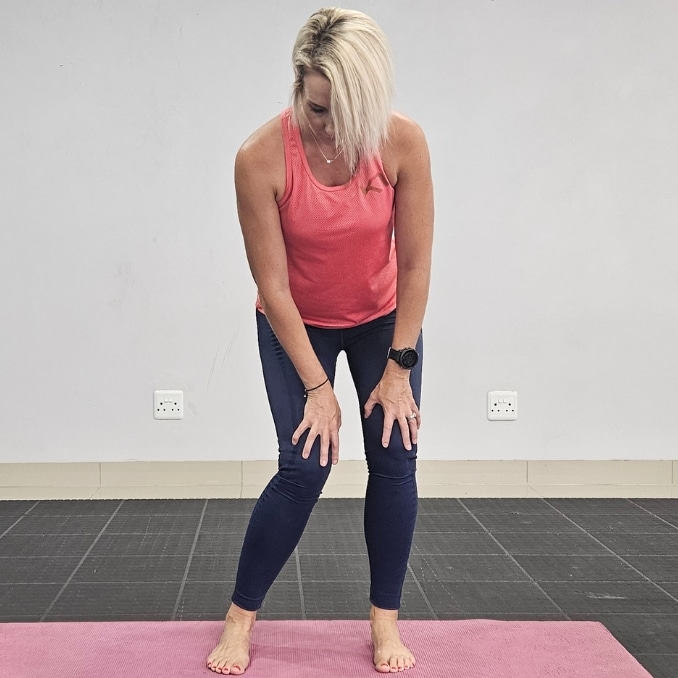 |
2. Plantar Flexion
Begin in an upright sitting position on a chair with your knees bent and feet flat on the floor, maintaining proper alignment with your head, shoulders, and hips. Engage your core. Lift and straighten one leg out in front of your body. Working on the range of motion in the ankle joints, point your toes toward the floor. Return to the starting position and then repeat the movement. Complete for 10 repetitions on each foot.
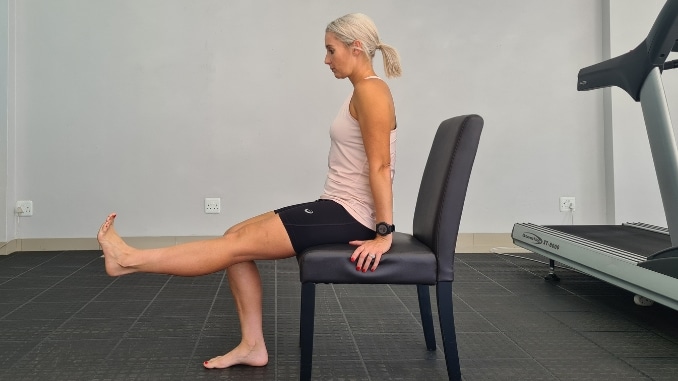 |
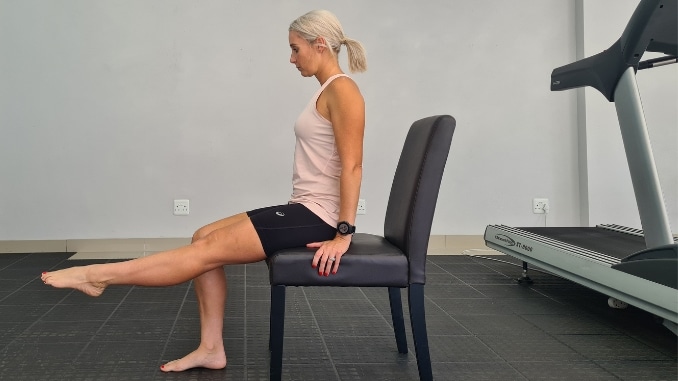 |
3. Dorsiflexion
For this exercise, utilize a mini-band, resistance band, or anything long that you can wrap around your foot for added resistance.
Begin in an upright sitting position on a chair with your knees bent and feet flat on the floor, maintaining proper alignment with your head, shoulders, and hips. Engage your core. Bend one knee to hip height and wrap the resistance band around your foot, holding the ends of the band in each hand. Engage your core and then straighten your leg, creating resistance on the band. Hold that position for a couple of seconds. Return to the starting position and then repeat the movement on the other foot. Complete the movement for 5 repetitions on each foot.
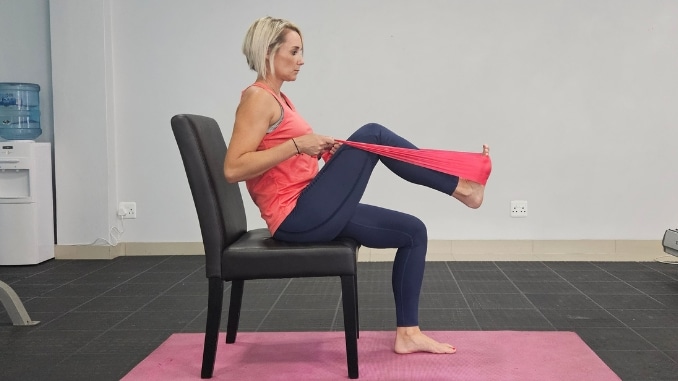 |
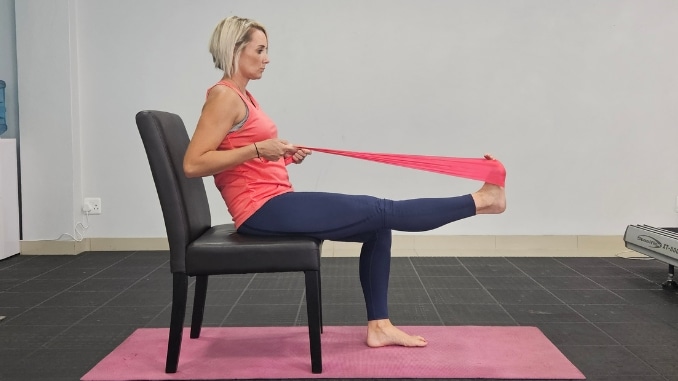 |
4. Toes and Heel Lifts
Begin in an upright standing position with your feet hip-width apart, maintaining good alignment with your head, shoulders, hips, and legs. Press your palms together at chest height. Engage your core and shift your weight onto your heels, raising your toes toward the ceiling. Alternate the movement by rocking your body forward to raise to your toes on both feet. Hold each position for 3 to 5 seconds. Repeat the sequence of movements for 5 to 10 repetitions.
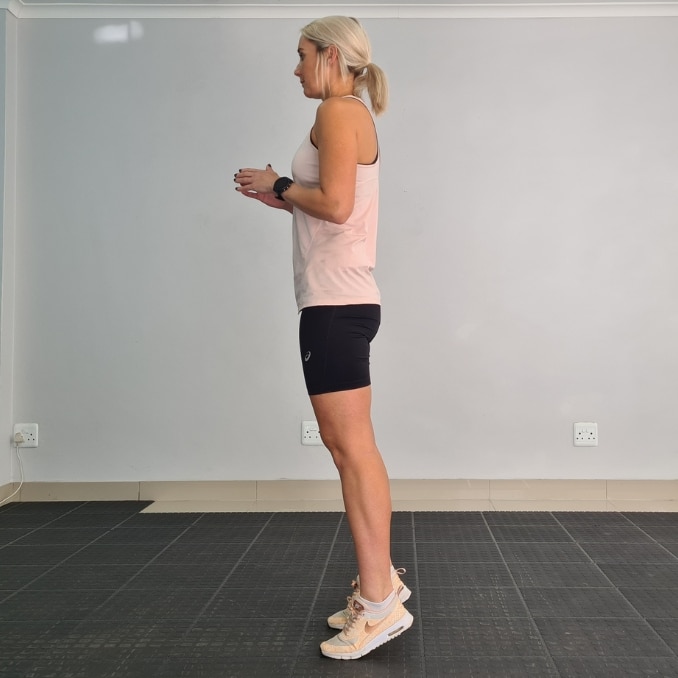 | 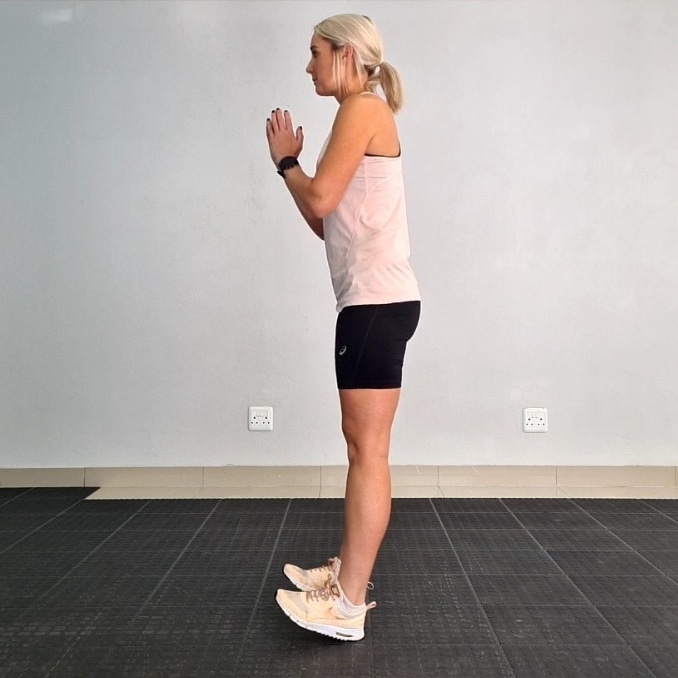 |
5. Heel Drop
For this exercise, utilize the back of the chair or wall for support if needed.
Begin an upright standing position in front of a chair, with your feet hip-width apart. Maintain good alignment with your head, shoulders, hips, and legs. Place the folded towel right behind the chair’s foot. Step on the folded towel with your toes on top of the blanket, dropping your heels to the floor with your body weight evenly distributed across. Hold the position for several deep belly breaths, in through your nose and then out through your mouth. Return to the starting position and repeat the movement.
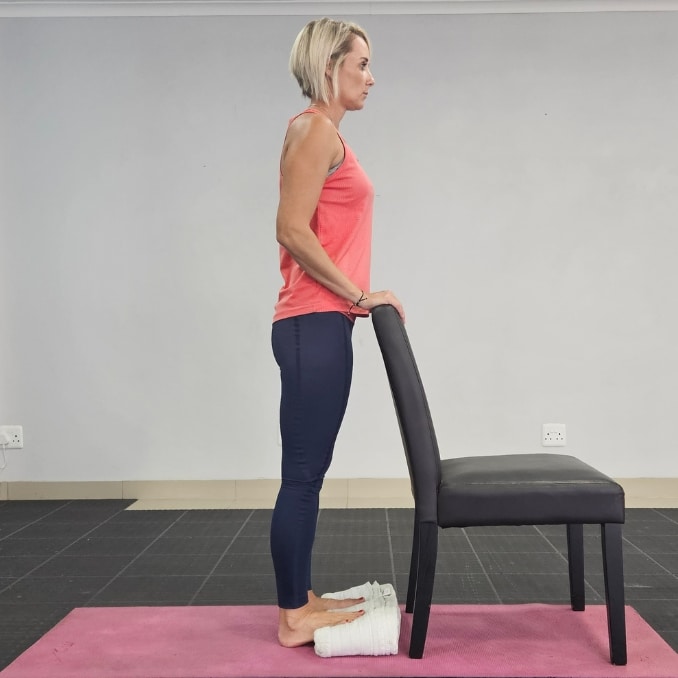
Variation 1 – Heel Drop
For this exercise, use the bottom step of your stairs, a yoga block, or any elevated surface to perform the movement safely.
Begin an upright standing position on the edge of the bottom step of your stairs or any other stable elevated surface. Maintain a good alignment with your head, shoulders, hips, and legs. Looking for a light stretch on your calf area, drop your heels off the edge of the surface. Alternate the movement by rocking your body forward and lifting your heels to raise to your toes on both feet. Hold each position for several deep belly breaths, in through your nose and then out through your mouth. Repeat the movement as needed.
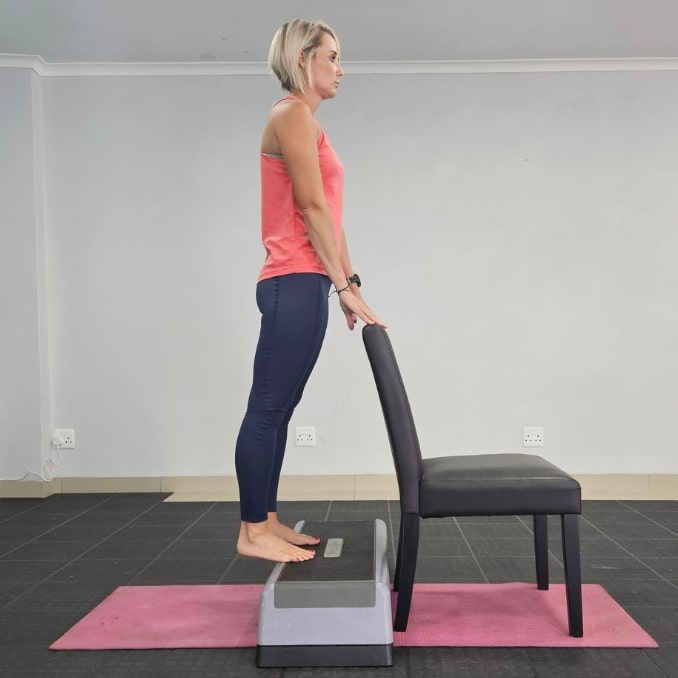 | 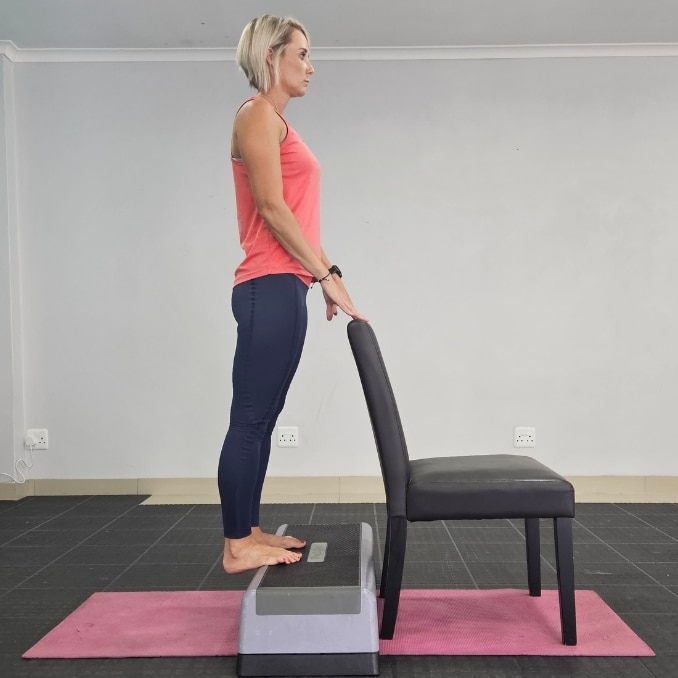 |
Note: Be careful not to fall off and hurt yourself. Always use a chair or something sturdy for support and balance.
After the routines, do some counter stretches by flexing your foot in a circular movement or moving it from side to side. It is also important to rest your legs on top of a chair or place them on the wall for elevation to give yourself and your ankles a break before finishing the exercises.
Conclusion:
Turning weak ankles into resilient pillars of strength involves understanding the causes of weakness and adopting a comprehensive approach. Specific exercises tailored to relieve pain from weak ankles are crucial for building stability.
Recognizing the impact of weak ankles in daily life and taking proactive steps, such as improving balance and flexibility or choosing supportive footwear, contributes to this transformation. It invests in long-term health, ensuring ankles recover from fragility and become sturdy foundations for a life filled with movement and enduring strength.
Stop living with the fear of re-injury. Check out this Ankle Sprain Solved now!


